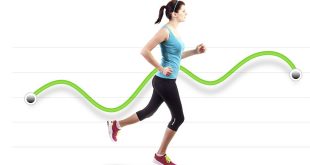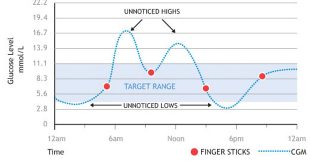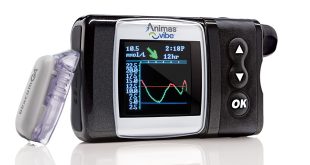Continuous glucose monitoring (CGM) systems are a welcome addition to the variety of devices that people with diabetes can take advantage of to ensure they keep glucose levels in check. Here are some tips for making the most of your continuous glucose monitoring system.
Many people with diabetes – whether you’re type 1, or type 2 and dependent upon insulin to manage your diabetes – can benefit from a CGM system. This is particularly true if your A1C levels are higher than recommended. (The Canadian Diabetes Association clinical practice guidelines recommend that A1C levels should be 7% or lower).
Remember, though, that with CGM, the need for traditional finger stick blood glucose measuring is not eliminated. You’ll still need to test your blood glucose when you calibrate your CGM system, and also to confirm whether you have hypoglycemia or hyperglycemia before taking corrective action.
Because the CGM system issues an alert when highs or lows are approaching, some people have reported developing ‘alarm fatigue.” Thus, information overload and the ability to make effective decisions about what to do with numbers and trends may be challenging. That’s where your healthcare team comes in: always consult with them, and share your CGM system data with them, so that together you can decide when – and if – your diabetes regimen should change, based on the CGM data. In a way, think of it like learning to drive – the longer you do it, the better at it you get!
The alerts and trend information will ultimately prove invaluable for you, once you become used to receiving them, as they can help you to prevent hypoglycemia before treatment is required. Proactively preventing hypoglycemia is better than reactively treating it. As well, it helps to avoid overtreatment and potential rebound highs.
This is true for both food intake and exercise:
- CGM will show you how quickly food impacts your blood glucose. You’ll soon see how long it can take for insulin to start working to match food that you’ve eaten.
- As well, seeing how your blood glucose behaves in response to various types and intensities of exercise can be very powerful in helping you to understand your body and how to manage insulin around different activities.
Bear in mind, however, that CGM doesn’t catch all lows 100% of the time.
Finally, remember also that you can’t just attach the CGM sensor and forget about it! Wearing a CGM system gives you valuable information, but it is only helpful if you actively use it. You must continue to be an active participant in the management of your diabetes to realize the benefits that CGM can offer.
This article has been made possible by an unrestricted educational grant from Animas Canada.
 Diabetes Care Community Learn, connect and care
Diabetes Care Community Learn, connect and care




